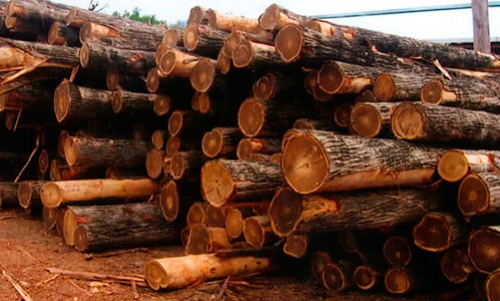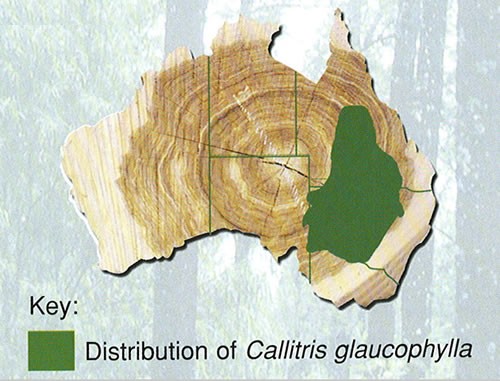Australian Cypress
Australian Cypress – The Tree
The species is adapted to growing in the lower to moderate rainfall areas, utilising a deep rooting system reaching well below the surface to stored soil moisture.
Cypress Pine often grows in association with some eucalypts and angophoras (eg. red ironbark, smooth barked apple).
Australian Cypress – The Wood
In colour cypress ranges from the light cream of the sap wood up to a very dark brown (dark chocolate) of some of the interior hardwood of some mature trees. The occurance of large and small knots is a characteristic of the material but this characteristic also provides remarkably decorative figure on the planed surfaces. Typically the knots are tight knots which do not readily fall out of the sawn wood.
The wood has a distinctive odour, most noticable when freshly sawn or planed. This odour is attributed to an included nature resin which is apparently an effective repellant for termite species. The heartwood of cypress is ranked as termite resistant.

Cypress is regarded as a very durable timber, hard wearing (hence useful flooring material), decorative (as internal clear finished panels and furniture), readily painted, low shrinkage (from green) and with good nail holding properties.
Described as a multipurpose building timber, cypress* is useful as fence post (de-sapped) poles, cladding, fascias, bargeboards, decking, internal flooring, internal lining and panelling, external and internal joinery and house framing and furniture.
Because of the relatively tight grain and relatively high density, care should be taken in nailing cypress. In many situations it is advisable to use blunted nailed (chisel point) or pre-drill nail holes to avoid end splitting. These precautions are often wise practise when working with seasoned cypress.
Cypress timber dries quickly but the surface often develops fine checking (very fine surface cracks). On weathering hense for exterior use weather boards, it is desirable to prime-coat the boards before drying which then enhances the overall performance of the final painted finish.
While it is desirable to use seasoned T & G flooring boards for a decorative clear-finished timber floor, the low shrinkage and quick drying characteristic of cypress can provide an economical advantage to owner builders and builders if they revert to a traditional method of laying the floor. This old method required floor boards to be cut into the rooms then loose-laid upside down to form a working platform. After several weeks or months, the site-conditioned boards would be reversed and fixed in place needing only light cramping for a tight floor.
Timber Properties
Each particular species of timber has unique characteristics and a comparison is sometimes useful if a particular use is envisaged so that the materials can be used economically, or to create the desired visual effect or to achieve high wear resistance and so on.
Australian Cypress – Where Does It Grow?
Over 90% of Cypress is harvested from natural regrowth forests in western NSW that lie in a band extending from Wagga Wagga and Griffith in the south to Moree and Inverell in the north.
These regrowth forests extend into southern Queensland.

ecoSelect Timber : Natural timber from ecologically sustainably managed forests
Natural timber, sustainably harvested and regrown in Australian forests.
ecoSelect Timber Harvesting
Harvesting of natural timbers from forests that are licensed and / or controlled by State Governments ensuring forest values are protected for current and future generations. ie. harvesting is governed by the State Code of Forest Practices, Forest Management Area and prescriptions, Regional Forest Agreements and all of the relevant State and Federal Acts and regulations including the Floral and Fauna Guarantee.

